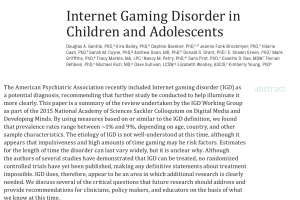Abstract
The American Psychiatric Association recently included Internet gaming disorder (IGD) as a potential diagnosis, recommending that further study be conducted to help illuminate it more clearly. This paper is a summary of the review undertaken by the IGD Working Group as part of the 2015 National Academy of Sciences Sackler Colloquium on Digital Media and Developing Minds. By using measures based on or similar to the IGD definition, we found that prevalence rates range between ∼1% and 9%, depending on age, country, and other sample characteristics. The etiology of IGD is not well-understood at this time, although it appears that impulsiveness and high amounts of time gaming may be risk factors. Estimates for the length of time the disorder can last vary widely, but it is unclear why. Although the authors of several studies have demonstrated that IGD can be treated, no randomized controlled trials have yet been published, making any definitive statements about treatment impossible. IGD does, therefore, appear to be an area in which additional research is clearly needed. We discuss several of the critical questions that future research should address and provide recommendations for clinicians, policy makers, and educators on the basis of what we know at this time.
This article was published in a special 2017 supplement of Pediatrics, a journal of the American Academy of Pediatrics. The supplement, “Children, Adolescents and Screens: What We Know and What We Need To Learn,” was produced by Children and Screens and includes the contributions of more than 130 interdisciplinary authors across 22 papers. See a complete list of articles included in the supplement.
